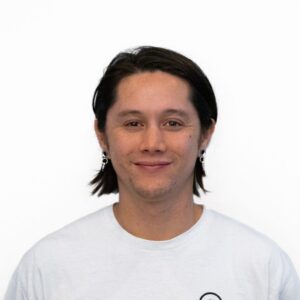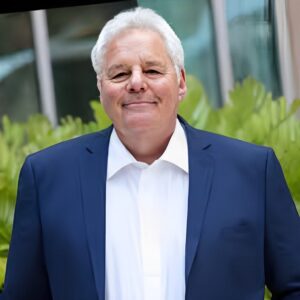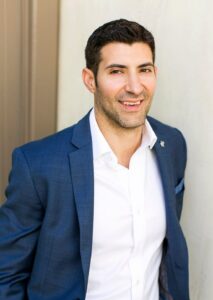An Interview With Fotis Georgiadis
Your decisions will be questioned, usually by those who do not make real decisions at all.
As a part of our series called “Making Something From Nothing”, I had the pleasure of interviewing Ed MacDonald.
Ed MacDonald is an American Inventor, Entrepreneur and Owner of MB Innovations. MacDonald, the consummate inventor, has designed a patented door lock system, an automatic cash-counting safe and a medical hot and cold pack over the course of his career. His latest creation, Buffalo Carts, has raised more than $120K on Kickstarter. The 65-year-old’s extensive résumé also includes stints as an aircraft mechanic and a printing company proprietor. MacDonald has embraced his failures — such as a mesh laundry bag he created with individual slots for pairs of socks — and says his family provides the support to keep him moving forward.
Thank you so much for doing this with us! Before we dive in, our readers would love to learn a bit more about you. Can you tell us a bit about your “childhood backstory”?
I was born in the U.S., but at the age of six I moved to the jungles of Papua New Guinea with my brother and parents, who were missionaries. Living in the jungle, in an actual grass hut in my early years, taught me to embrace hard work and the value of innovation with the materials at hand. I also learned at an early age that you can’t allow fear of the unknown to serve as an excuse for inaction.
My parents incredible work ethic left me with a lifelong example of personal responsibility, a desire to make a positive impact in others lives and to stay true to your passions.
Their work as missionaries had a tremendous impact on my childhood. I had a front row seat to their selfless dedication, and the selflessness of others, showing me the value of a cause greater than oneself. I was instilled with the importance of living life on purpose. My parents were always supportive and encouraging in my many business endeavors and their example of selfless dedication and persistence has been a lifelong example.
Can you please give us your favorite “Life Lesson Quote”? Can you share how that was relevant to you in your life?
I like the quote by Zig Ziglar, “You don’t have to be great to start, but you have to start to be great.”
There were times throughout my life when I decided to pivot or questioned my current direction. There would always be questions like, “How do I do this?” and “Where do I go to get help when I don’t know enough?” The answers to those questions always came back to starting somewhere.
Just start now, create momentum, learn and keep moving with whatever you’re doing. I benefited greatly from realizing and accepting that no one was born with experience and knowledge. Learning and experiencing take time and reaching out to others with experience is ok, too.
Is there a particular book, podcast, or film that made a significant impact on you? Can you share a story or explain why it resonated with you so much?
The book “Will It Fly?” by Pat Flynn made a great impact on me, both in product development and launching a business. In the book, he lays out a step-by-step guide for testing a business idea with small-scale “litmus tests,” action-based exercises and goes to great lengths in testing your personal reasons and abilities to be in business and to stay the course.
Flynn’s book helped me ensure my target ideas align with and support my original vision. It helped me focus on the actual validating and testing of an idea with a small target market. His book challenged me to, “think critically, act deliberately and dare greatly” which led to my latest business launch of Buffalo Carts LLC.
Ok super. Let’s now shift to the main part of our discussion. There is no shortage of good ideas out there. Many people have good ideas all the time. But people seem to struggle in taking a good idea and translating it into an actual business. Can you share a few ideas from your experience about how to overcome this challenge?
I am always full of ideas which stem from my upbringing. I can see challenges around me that relate to efficiency and practicality. I’m constantly thinking about potential solutions to a problem. For me, the challenge came down to transforming ideas into a physical product or proto-type.
I launched a product, with my first company, that I designed and patented. I stumbled through the product development process, making many mistakes along the way. I realized early on that there were particular skills I needed, such as mechanical design, prototyping, manufacturing, marketing, and business management.
I set a goal to hone those individual skills, and put a plan in place to learn from others in those fields. With my degree in Aviation Technology, I realized I needed more mechanical design experience so I worked with a CAD software company for three years. There, I gained design skills and broad-based experience with manufacturing companies.
I gained my product design and product manufacturing experience with a national automated safe counting company. From there, I started my own design and product development company and went on to hone marketing and business skills.
Often when people think of a new idea, they dismiss it saying someone else must have thought of it before. How would you recommend that someone go about researching whether or not their idea has already been created?
Let technology be your friend. With today’s technology, there are many ways to research products. Google and other search engines use 20–30 different key word searches that include some part of the idea. After gaining more insight about an idea through a search engine, go to www.uspto.gov and do a keyword search for patent information.
Sometimes ideas can be patented without going to market. If you don’t find anything representing your idea you may want to pay for a patent attorney. They can conduct a patent search to assure you about your idea before you spend money on development.
For the benefit of our readers, can you outline the steps one has to go through, from when they think of the idea, until it finally lands in a customer’s hands? In particular, we’d love to hear about how to file a patent, how to source a good manufacturer, and how to find a retailer to distribute it.
The first step is research. Research is key in order to learn if the idea or product is already on the market. If it is, research may help determine how it can be improved.
The second step is creating a prototype. Depending on the product, there has to be proof of concept to show how the idea actually works, and how the product can be manufactured or deployed. This usually means utilizing design or engineering firms. Prototypes are also good for initial test marketing and customer feedback.
Step three, if necessary, is to file a Utility or Design Patent. In most cases a less expensive Provisional Patent can be filed giving the filer 12 months to market test the product while saying “Patent Pending”. The choice to file a Utility or Design Patent during that 12 month period is up to the individual. Most cases range from $5,000- $10,000K or more, depending on the complexity.
See https://www.uspto.gov/patents/basics
Step four is design for manufacture. At this step, the product is designed for mass production of the final product. This incorporates design changes to develop costing matrixes for marketing, and gives the inventor the set of drawings, or CAD files, to get manufacturing quotes.
Step five is to identify manufacturing companies for production. There are various lists of manufacturing companies. Use the website https://www.thomasnet.com/ to help locate different kinds of manufacturing. I’ve found that manufacturing partners are a great way to establish a market presence and sometimes, better pricing.
Step six includes marketing and sales. Getting product exposure and initial samples out to the sales channels is paramount. This is accomplished by either identifying companies that sell similar products (google search) and approaching them with product information or a product demonstration video, or identifying new market channels and approaching them with the same info.
Either way be prepared to discuss cost, delivery schedules, marketing budgets, and long term goals.
What are your “5 Things I Wish Someone Told Me When I First Started Leading My Company” and why?
- It’s a lot harder than it looks and the Pandemic didn’t help but we survived.
- Get the right team together, it’s critical! You quickly learn that everyone doesn’t have the stamina for the startup environment.
- It costs more than everyone initially thought. Even with the best planning, the unexpected should be expected.
- Staying true to your vision is not always popular, but necessary.
- Your decisions will be questioned, usually by those who do not make real decisions at all.
Let’s imagine that a reader reading this interview has an idea for a product that they would like to invent. What are the first few steps that you would recommend that they take?
Find a need and fill it!
Do your research to see if the idea is already out there. This can be done by spending the time on search engines and US Patent Office www.uspto.gov, or hiring professionals such as patent attorneys.
If you don’t find something exactly like your idea, look broader for similar products to give you an idea of pricing and market reach.
Next, I would study where your idea can fit in the market, i.e. home improvement, phone chargers, security, kitchen utensils, etc. to give you an idea as to what those markets may be missing, and how your idea can possibly fit in.
There are many invention development consultants. Would you recommend that a person with a new idea hire such a consultant, or should they try to strike out on their own?
I would encourage anyone with a new idea to do all of the research upfront, on their own, before hiring such a consultant. There’s no need to pay someone a large sum of money only to learn that your idea already exists. Try and save yourself some money and fully commit yourself to research before paying others to find out information you may be able to learn for free.
I would suggest hiring a consultant, or firm, if you’re someone with no technical or marketing skills and have the cash to proceed. There are lots of business incubators that can provide help for free, or very small fees, and there are institutions like SCORE that have free seminars and mentors who can provide business help and guidance.
What are your thoughts about bootstrapping vs looking for venture capital? What is the best way to decide if you should do either one?
Having experienced both bootstrapping and VC, it all comes down to a person’s resources, business experience and the product. Some products that take lots of engineering and design with high production startup costs might entail significant startup capital, thus venture capital. The down side of course is that you can give up a significant amount of equity and there are now additional pressures to bear.
On the other hand, if you have a product that can be started with minimal cash, get out to the market for testing and then gradually scale up from there, that means you now have that capital from sales to continue the scaling and profitability.
Ok. We are nearly done. Here are our final questions. How have you used your success to make the world a better place?
Making the world a better place doesn’t have to come in the form of grand gestures. It can be done on a small scale, or a daily basis. I view sharing my perspective and experiences here as a way to make the world a better place. My hope is that sharing my experiences in product design and development, the do’s and don’ts, my mis-steps and successes will help others achieve their goals.
I believe in giving back, helping those looking to grow and offering an example of my experiences for others to learn from. I’ve been fortunate to serve on advisory boards such as The Werx in McKinney TX, a business incubator, helping small business and individuals with free design consulting. I’ve also helped with a 3D printing lab for Tech Culture McKinney.
You are an inspiration to a great many people. If you could inspire a movement that would bring the most amount of good to the most amount of people, what would that be? You never know what your idea can trigger.
Having lived in places such as Papua New Guinea, southern Mexico and Nepal, I experienced, firsthand, how much need there is. That experience fuels my desire to help those in need.
I am focused on building my company that generates profits to connect with organizations that help 3rd world countries with life changing innovations to address basic needs.
We are very blessed that some of the biggest names in Business, VC funding, Sports, and Entertainment read this column. Is there a person in the world, or in the US, with whom you would love to have a private breakfast or lunch, and why? He or she might just see this if we tag them.
Living in McKinny Texas, a suburb of Dallas, I hear and see a lot of Mark Cuban. He is the owner of the Dallas Mavericks and one of my entrepreneurial heroes. I’ve admired his drive and ability to get things done. I admire his “hustle” coupled with his ability to help countless others along the way.
I’ve learned over the years that perspective and drive are some of my greatest tools. I’d love to hear his perspective on business in general and where we could do the most good with our success.
Thank you for these fantastic insights. We greatly appreciate the time you spent on this.
Making Something From Nothing: Ed MacDonald Of Buffalo Carts On How To Go From Idea To Launch was originally published in Authority Magazine on Medium, where people are continuing the conversation by highlighting and responding to this story.



